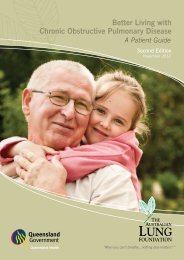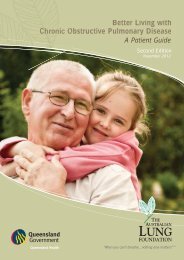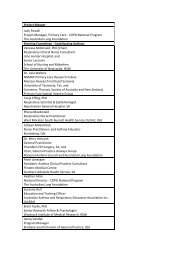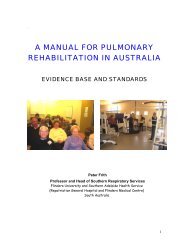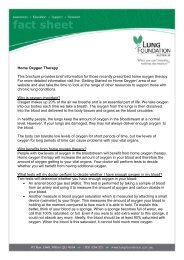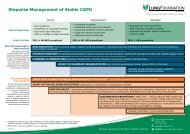view Dr Markos's submission - Lung Foundation
view Dr Markos's submission - Lung Foundation
view Dr Markos's submission - Lung Foundation
You also want an ePaper? Increase the reach of your titles
YUMPU automatically turns print PDFs into web optimized ePapers that Google loves.
and if there are temperature inversions, then that wood smoke will hoverclose to the ground all night, even if the ongoing smoke production ismuch less. In addition, even a modern heater will continue to produce alot of smoke if the wood used is not dry and if it is not placed correctly inthe wood heater. New wood heaters are now designed without a controlto dampen the air vent. However, there are reports of some operatorsmodifying the manufacture of the devices to permit dampening of the airvent so that the last load of wood can burn more slowly overnight. Thispractice increases wood smoke. A study of new wood heaters showedthat only a minority complied with the manufacturer’s claims about theirburning efficiency, even with optimal usage. These are all reasons todiscourage new installations of wood heaters in populated areas.Each person can choose not to smoke tobacco products and they canactively avoid being exposed to other people’s tobacco smoke.Government regulations in Australia are very good at assisting people tonot be exposed to tobacco smoke, by banning smoking in confined publicplaces. However, a non-smoking Australian living in a region with highparticle pollution levels, is unable to escape that pollution and theassociated risks without moving to a different location. This fact, togetherwith the absence of a safe threshold level of exposure to wood smoke,provides a powerful reason as to why Governments should regulate theburning of wood to protect the population.In conclusion, particle pollution from all sources, and especially from woodsmoke, is harmful to our lungs. Residents should be encouraged andassisted to switch to safer alternative home heating. The burning of woodin residential areas should be regulated and discouraged, to protect allresidents. This should help all residents to breathe more safely in winter,particularly those who have asthma or other chronic lung illness.Yours sincerely,<strong>Dr</strong> James MarkosRespiratory PhysicianReferences:Pope CA, Schwartz J, Ransom MR. Daily mortality and PM10 pollution inUtah Valley. Arch Environ Health 1992;47:211-17.Lyons L. Air pollution, environmental and respiratory diseases, Launcestonand Upper Tamar Valley Tasmania. Launceston City Council, 1996;63.24.Air Quality and Health, European Respiratory Society, May 2010http://www.ersnet.org/images/stories/pdf/web-AQ2010-ENG.pdf




